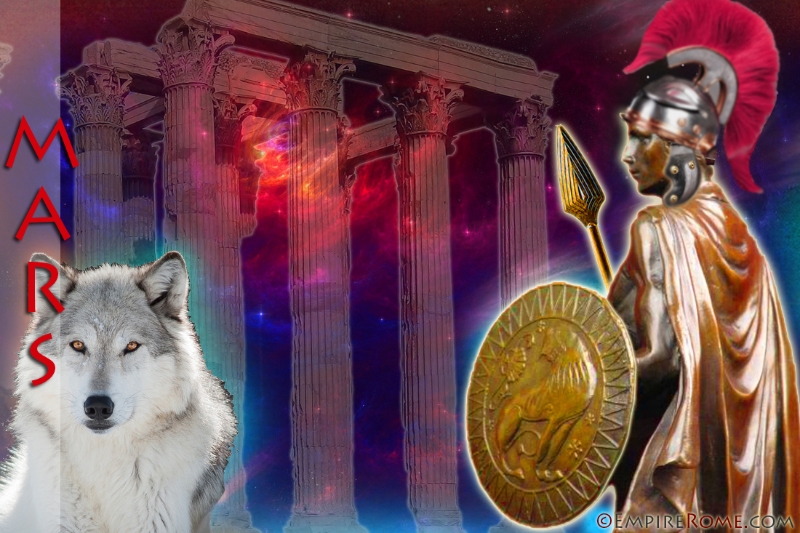
| MARS “God of War” | |
| God of: | War, agriculture, fertility, protector of cattle, fields, boundaries and vegetation |
| Type: | Major – Second only to Jupiter |
| Roman Name: | Mars |
| Greek Name: | Ares |
| Other Names: | Mars is known by several other names, Roman and foreign |
| Festivals: | March 1, the Feriae Marti, and October 19 the Armilustrium |
| Shrine/Temple: | Temple of Mars Ultor |
Overview
Mars was originally the Roman god of fertility, protector of cattle, fields, boundaries, and vegetation. He was also the god of spring since it is believed he presided over agriculture throughout the Ancient Roman Empire. It was not until later that Mars became associated with war and battle—revered by Ancient Roman legions. Ancient Roman society considered Mars only second in importance to Jupiter, king of the gods. Mars was also known as the consort of Rhea Silva and their children, Romulus and Remus who were the legendary founders of Ancient Rome.
Mythology
Mars is the son of Juno, Queen of the gods. Legend states that Juno was impregnated by a magical flower and later gave birth to her son Mars. Mars was married to Nerio the Ancient Roman war goddess (sometimes associated with Bellona). Venus, the goddess of love, was also Mars’ lover. Mars and Venus had three children together: Eros, Concordia, and Cadmus.
Mars’ Greek counterpart was Ares; however, Ares and Mars did not share many of the same characteristics. Ancient Greece’s god of war Ares was typically loathed by the people because he was a vile warmonger. Mars on the other hand was not. Mars waged war in order to restore or keep peace while Ares waged war for bloodlust, vengeance, and conquest. Mars was respected and held great importance in the Ancient Roman state.
Mars was held in a higher regard then his counterpart Ares because of the mythological story of Rome’s foundation. Mars had such a huge influence on Roman society because he was considered the father of the city Ancient Rome. Mars was more importantly the protector of Rome and created confidence in the Ancient Roman military. In antiquity, people usually appointed a god or deity to protect a city.
Festivals and Worship
Most notably out of respect, Ancient Romans held Mars’ festivals on March 1, the Feriae Marti, and October 19 the Armilustrium. These festivals comprised of weapon storing and cleaning in Mars honor.
Duties, Attributes, and Symbols
Mars was offered sacrifices before battle because of his warlike characteristics. Mars was said to appear on the battlefield with Bellona. Bellona was the warrior goddess of Ancient Rome and appeared in many areas with Mars. Differing stories suggest that Bellona is Mars’ wife or sister.
Mars is mostly depicted as a warrior in full battle armor used by the ancient Romans—wearing a crested helmet and holding a shield and spear. The month March is named after him.
Animals and plants sacred to Mars were the wolf, woodpecker, laurel, and herbs. The wolf holds great importance because a she-wolf saved and nursed Mars’ twin boys, Romulus and Remus to health when they were infants. Romulus later became the founder of Rome, according to Ancient Roman myths.
Fun Facts
The month of March gets its name from the Ancient Roman god Mars.
The Planet Mars: The fourth planet from the Sun is named after Mars, the Ancient Roman god of war. Mars is the second smallest planet in our solar system since Pluto is no longer a planet. The planet Mars is also associated with the Ancient Roman god of war because of its red appearance and the color red is associated with fiery figures and personalities. This red color is due to the abundance of iron oxide on Mars’ surface.
Click here to return to Ancient Roman Gods and Goddesses list.

